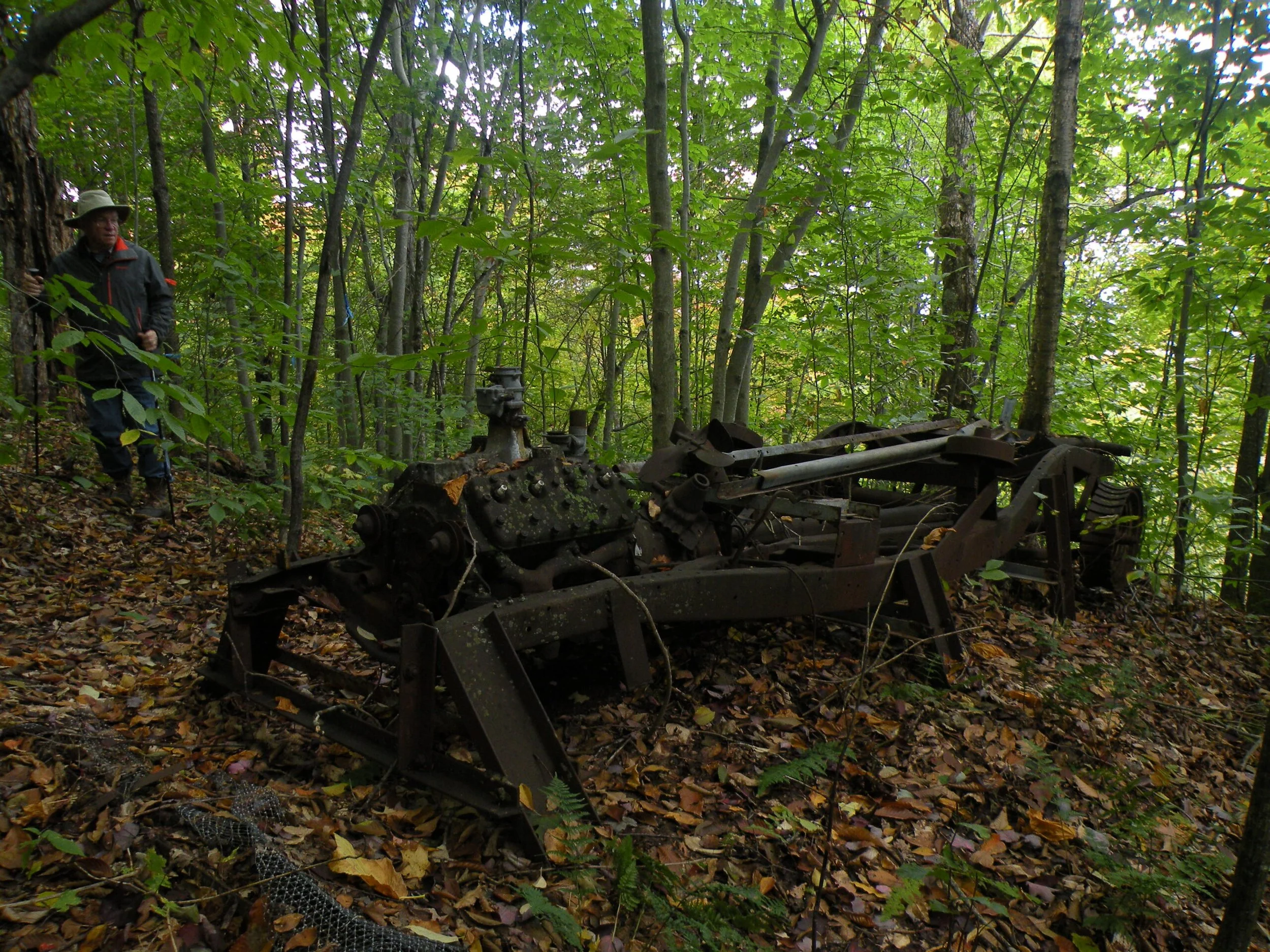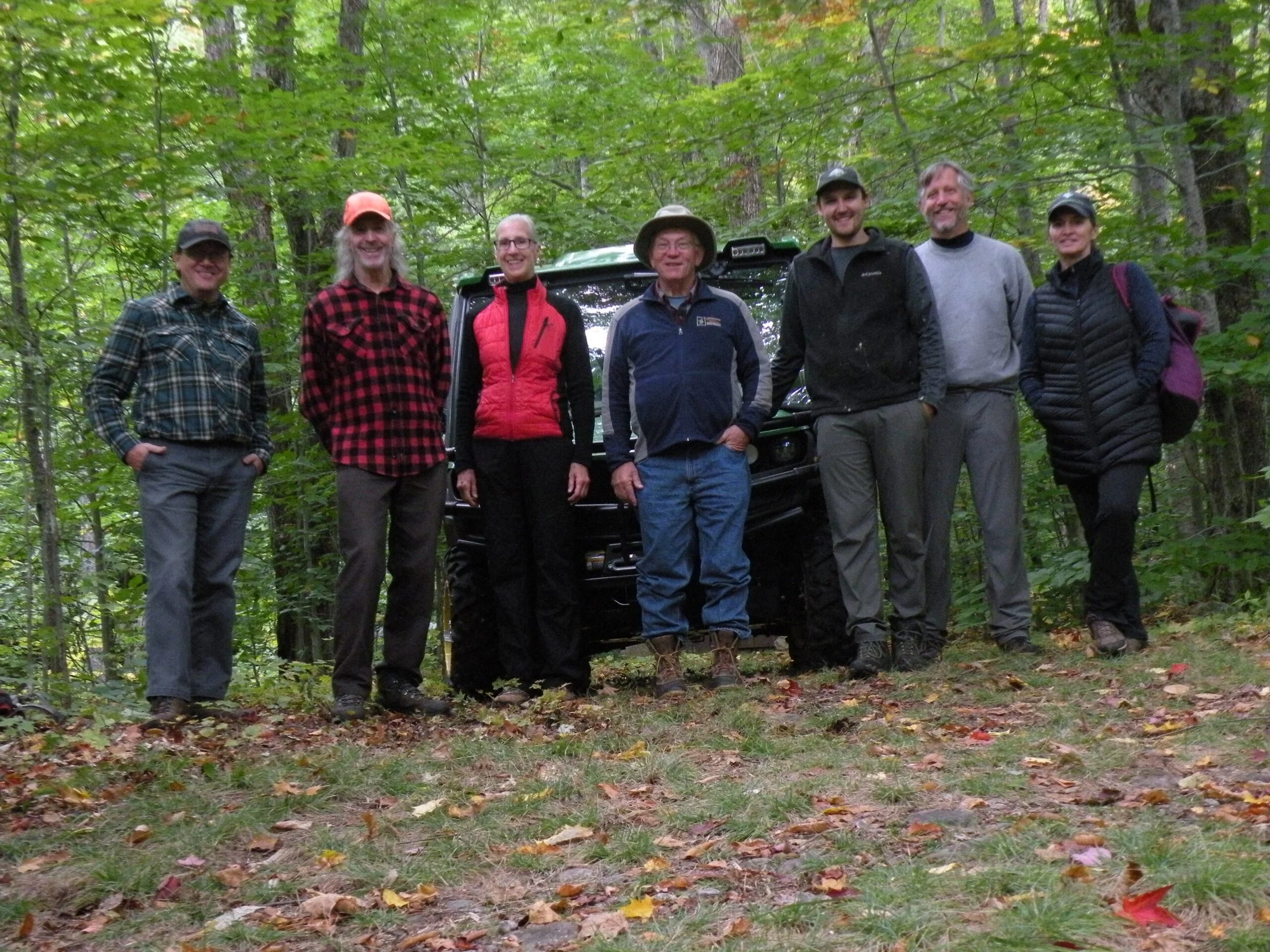Adapting to Jenkins Mountain
Chad Dawson knows a little bit about recreation and wilderness management. Professor Emeritus of Recreation Resources Management at SUNY ESF and a former APA Commissioner, Dawson is uniquely qualified to help shepherd the State of New York toward adaptive management, a new management paradigm for the Adirondack Forest Preserve.
Checking out the old rope tow machine
Today Dawson serves on Adirondack Wild’s Board of Directors, as well as AWA’s Technical Advisor. Therefore the two organizations saw the opportunity to form an alliance to demonstrate adaptive management with a real-world project under Dawson’s leadership. That project, the Jenkins Mountain Backcountry Skiing Project, is entering its third year with a full head of steam.
For the coming 2022-2023 winter season, the Jenkins Mountain backcountry ski trails will open for public use. This project is one of AWA’s most significant undertakings, and it is a great opportunity to support a project that will help spur better protection of the Adirondacks’ wild places. Both the Department of Environmental Conservation (DEC) and Adirondack Park Agency (APA) are working on substantial projects that will use adaptive management in 2023, and both have engaged with us to learn from our experience.
There could not be a more important time to support our work, and we need your help to continue leading on this critical issue. It’s also a chance to enjoy an exciting new backcountry skiing locale.
Background
Adaptive Management, which we have previously described here, employs a methodology that marries desired conditions with monitoring and data analysis to drive iterative, responsive adaptations to changing conditions on the ground. This is something that the Adirondack Park desperately needs as it strains under dynamic problems like climate change, invasive species, increased visitation and massive spikes in usage that can occur on any sunny day. Adaptive management was the cornerstone recommendation by the DEC-sponsored High Peaks Advisory Group (HPAG), of which AWA was a member.
As 2023 approaches, AWA can say that the State of New York has begun to take the HPAG’s recommendation seriously. This summer, the DEC issued a Request for Proposal for Professional Visitor Use Management (VUM) Planning Services, which will bring in an expert contractor to establish a pilot VUM project in the High Peaks in 2023 and 2024, a step which the HPAG also recommended. In addition, the APA is now regularly talking about adaptive management and VUM as key parts of Park policy. From AWA’s perspective, the State is on the verge of generational change in wilderness management that will more effectively protect the Adirondack Park.
While VUM and adaptive management are not new ideas, they are not something with which the DEC has a lot of experience. Misconceptions have persisted. AWA heard multiple times from DEC administrators that while VUM sounded good, they did not have the resources to implement it on any kind of scale.
In fact, in contrast to the top-heavy and largely static Unit Management Planning process the DEC has employed since the 1970s, adaptive management is responsive, light on its feet and does not require a massive investment in resources or time. There is a huge advantage in not having to have all the answers up front, but rather to learn and adapt as the process unfolds. This is exactly how to address dynamic problems like the ones the Park faces.
Exploring the Proposed Ski Trails
Scott van Laer, the Director of Paul Smiths Visitor Interpretive Center (VIC), is also a member of AWA’s Board of Directors. With the VIC looking to expand their recreational offerings, and with Chad Dawson available as an expert resource, AWA and Adirondack Wild saw an opportunity to create a project of modest scope on private property, led by Dawson, that could demonstrate VUM and the adaptive management process.
In particular, the project could show that the resource demands to drive adaptive management are not as great as some assume. A project team was formed and after assessing options, determined that the best fit for the VIC was to develop and manage a backcountry skiing area on Jenkins Mountain in the northwest corner of the VIC property. The team partnered with expert backcountry skier Ron Konowitz and the Adirondack Powder Ski Association to design and build a first-class backcountry ski trail system.
Jenkins Mountain Team
What We’ve Done So Far
In 2021 the project team put together put a detailed plan and developed an initial version of the backcountry skiing area. Chad Dawson developed a VUM framework to guide the work. Potential trails were flagged, the terrain underwent an initial assessment, and Paul Smiths staff installed trail cameras to monitor both human and wildlife usage.
In the fall of 2021 and summer of 2022 trails were designed and built by Konowitz and volunteers, with meticulous documentation of all trees cut by diameter and type, blowdown removal and conditioning of ground hazards. Team members conducted limited skiing on the trails in the winter of 2022 to test the layout.
An initial public hearing was held to involve stakeholders in the overall planning process, especially to help the project team to define the desired conditions, visitor opportunities and needed facilities. In the spring and summer of 2022 the project team briefed the DEC and the APA on the project, and both agencies remain engaged with us. A visitor use survey and plan was developed.
The current trail system has an uphill (skin track) trail and three primary trails descending several hundred feet of vertical through open woods. These trails are not appropriate for beginners: the target is intermediate and advanced backcountry skiers.
Jenkins Mountain Ski Trail Map
What’s Next
In the winter of 2023, the Jenkins Mountain Backcountry Skiing Trails will be open for public use. Winter visitors to the VIC are required to acquire a day pass, and they will be asked a few short survey questions so that we can analyze visitor experience and trail usage. A kiosk and trail signage will provide basic information and direct skiers to the skin track.
Throughout the season the project team will measure visitor use and impacts, and in the summer of 2023 the team will publish a year-one analysis and share it with the DEC and the APA. We will use that analysis to respond to issues and improve both resource protection and the backcountry skiing experience.
How You Can Help
In 2023 and beyond, AWA intends to demonstrate a first-class VUM project to the DEC, APA and stakeholders to help the State move toward world-class wilderness management for the Adirondack Park.
First and foremost, if you are an experienced skier, come give the trails a try! If you do, please participate in our surveys. Nothing is more important than what we can learn from users, so your feedback is valued.
You can also help with a financial contribution to AWA of any size. We operate as a volunteer advocacy group, with no paid staff or lobbyists. Yet we undertake significant, resource-intensive initiatives like Jenkins, because concrete projects like these are the best way to fulfill our mission of protecting the Adirondack Park’s wildest places. Your support can help us make these projects a success.
See you on the trails!




